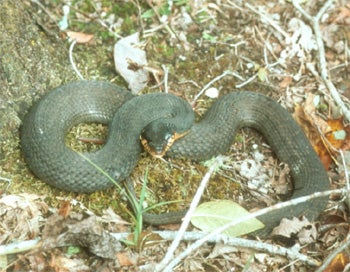SCIENTIFIC NAME:
Nerodia erythrogaster
STATUS:
Common statewide. Lowest Conservation Concern.
DESCRIPTION:
Plainbelly water snakes (Nerodia erythrogaster) are relatively large, thick bodied, harmless, semi-aquatic snakes. They often can be seen sunning on logs or overhanging branches from which they drop into the water when alarmed. These snakes often are confused with the venomous cottonmouth water moccasin (Agkistrodon piscivorous) and are killed needlessly. They will, however, bite hard and repeatedly when cornered or captured.
There are five subspecies of plainbelly water snakes in North America. Two of these are found in Alabama. Yellowbelly water snakes (Nerodia erythrogaster flavigaster)are usually 30-40 inches long, but can reach lengths of up to five feet. Their coloration is greenish gray on top and plain yellow underneath. Their scales are keeled. Hatchling snakes have distinct color patterns which fade with age.
Redbelly water snakes (Nerodia erythrogaster erythrogaster)are roughly the same size as their yellow bellied relatives (30-40 inches in length) with a 62 inch long individual having been recorded. Their coloration is brown on top with a plain red or orange-red belly. Their scales are keeled. Hatchlings are strongly patterned with a pinkish background color. Again, juvenile color patterns gradually fade with age.
DISTRIBUTION:
Plainbelly water snakes can be found from New Mexico and northern Mexico to Michigan and from Maryland to Florida. In Alabama, N. e. erythrogaster is confined to the extreme southeastern counties while N. e. flavigaster is found throughout most of the remainder of the state.
HABITAT:
Plainbelly water snakes can be found in a variety of aquatic habitats, but are most common in larger, more permanent bodies of water such as rivers, swamps, marshes, and ponds. During hot, humid weather, they will, however, wander considerable distances away from water.
FEEDING HABITS:
Adept swimmers and divers, plainbelly water snakes obtain most of their food from the water. Their diet includes fish, crayfish, salamanders, and frogs.
LIFE HISTORY AND ECOLOGY:
Like other North American water snakes and garter snakes, plainbelly water snakes bear live young. They breed from April to June and 5-30 young are born from August to October.
REFERENCES:
Cognant, R., and J.T. Collins. 1998. Reptiles and Amphibians Eastern/Central North America. Houghton and Mifflin Co., Boston, MA. 616 pp
AUTHOR:
Chas Moore, Wildlife Biologist, Alabama Division of Wildlife and Freshwater Fisheries






